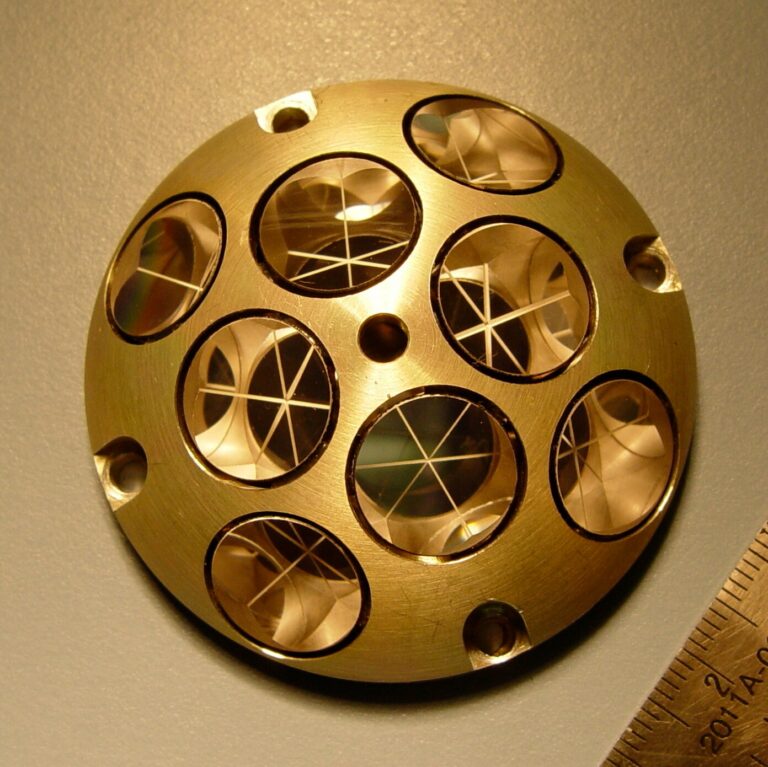Utilizing Basic Technology: NASA’s Approach to Monitoring Lunar Missions
NASA is utilizing a straightforward yet efficient technology known as Laser Retroreflective Arrays (LRAs) to enhance the accuracy of locating lunar landers. As part of NASA’s Commercial Lunar Payload Service (CLPS) initiative, these LRAs will be affixed to the majority of landers from United States companies. LRAs are cost-effective, compact, and lightweight, enabling future lunar orbiters or landers to easily locate them on the moon.
These devices consist of a small aluminum hemisphere, measuring 2 inches (5 centimeters) in diameter and weighing 0.7 ounces (20 grams). They are embedded with eight corner cube retroreflectors made of fused silica glass, each with a diameter of 0.5 inches (1.27 centimeters). LRAs are intended to be included in most of the upcoming CLPS deliveries destined for the lunar surface.
LRAs are specifically designed to reflect laser light from a wide range of angles. Dr. Daniel Cremons, the deputy principal investigator for the LRA project at NASA’s Goddard Space Flight Center in Greenbelt, Maryland, compares this to the reflective strips found on road signs that assist with nighttime driving on Earth. He explains, “Unlike a mirror where it has to be pointed exactly back at you, you can come in at a wide variety of angles, and the light will head directly back to the source.”
By directing a laser beam from one spacecraft towards the retroreflectors on another and measuring the time it takes for the light to return to its source, scientists can accurately determine the distance between them.
“We have been equipping satellites with these devices and measuring their range using ground-based lasers for many years,” states Dr. Xiaoli Sun, the principal investigator for the LRA project at NASA Goddard. “Then, twenty years ago, someone had the idea to install them on the landers. This allows us to measure the range to those landers from orbit and precisely determine their location on the lunar surface.”
Knowing the precise location of landers on another planetary body is crucial, and Laser Retroreflectors (LRAs) serve as markers that work in conjunction with orbiting satellites to establish a navigation aid similar to the global positioning system (GPS) we rely on here on Earth.
In addition, laser ranging is utilized for docking spacecraft, such as the cargo spacecraft employed for the International Space Station, as pointed out by Cremons. The LRAs illuminate when light is shone upon them, aiding in precise docking guidance. They can also be detected by lidars on distant spacecraft to determine their range and approach speed with exceptional accuracy, without the need for sunlight, enabling docking to occur even during nighttime.
Furthermore, Cremons highlights that these reflectors could enable spacecraft to accurately navigate their way to a landing pad, even in the absence of external light for guidance. This implies that LRAs could eventually facilitate spacecraft landings in pitch-dark areas near the lunar South Pole, which are of great interest for crewed missions due to potential resources like water ice.
Due to their small size and simple composition, LRAs can be included as a beneficial and low-risk addition to scientific missions. “On its own, it operates passively,” Clemons explains. “LRAs can withstand the harsh lunar environment and remain functional on the surface for decades. Moreover, apart from locating landers, laser ranging can also be employed to determine the position of orbiters around the moon.”
As additional landers, rovers, and orbiters are sent to the moon equipped with laser-ranging capabilities, our ability to accurately determine their locations will continue to improve. By deploying more laser retroreflectors (LRAs) on the lunar surface, scientists will be able to precisely gauge the positions of key landers and other points of interest. This expanding network of LRAs will enable us to accomplish even greater scientific achievements.
Currently, NASA’s Lunar Reconnaissance Orbiter (LRO) is the sole spacecraft orbiting the moon with laser-ranging capability. The LRO has already successfully ranged to the LRA on the Vikram lander of the Indian Space Research Organization, and it will continue to range to LRAs on future landers.
Under the Artemis program, CLPS deliveries will conduct scientific experiments, test technologies, and demonstrate capabilities to support NASA’s exploration of the moon and prepare for human missions. Through Artemis missions, NASA aims to land the first woman and the first person of color on the moon, utilizing innovative technologies to explore a larger portion of the lunar surface than ever before.
NASA will collaborate with commercial and international partners to establish a sustainable presence on the moon. The knowledge gained from our endeavors on and around the moon will then propel us towards our next monumental achievement: sending the first astronauts to Mars.
This article is republished from PhysORG under a Creative Commons license. Read the original article.
Do not forget to share your opinion with us to provide you with the best posts !




0 Comments